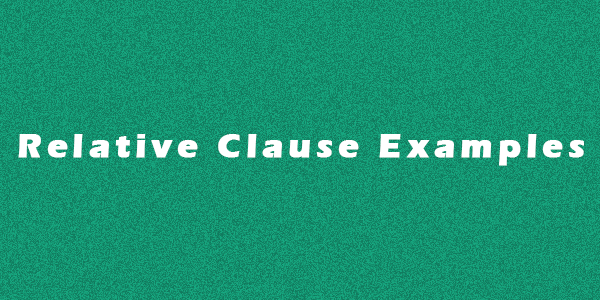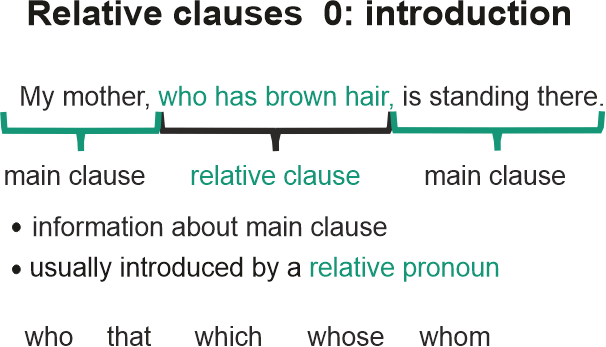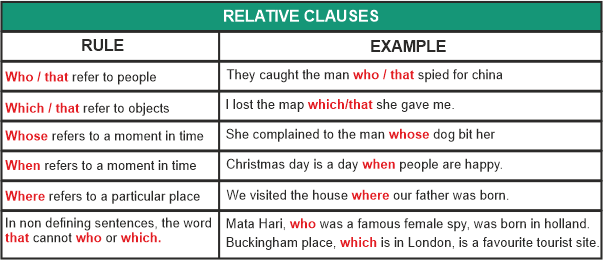Relative Clause ExamplesWhat Are Relative Clauses?A relative clause connects concepts by utilizing pronouns that refer to something addressed previously, allowing the writer to merge two separate clauses into one sentence. An adjective clause is another name for a relative clause. 
Relative clauses, also known as adjective clauses, are dependent clauses that alter nouns or pronouns. They consist of the subjects and the verb or verb phrases that are presented by relative pronouns and relative adverbs. These pronouns and adverbs are known as relative since they connect the clause to the words they alter. Relative pronouns include that, who, whom, whose, and which, whereas relative adverbs include where, when, and why. They are utilized to change the meaning of a noun that is either the subject or the object of a sentence. As an example:
"Who he saw at the wedding" is a relative clause that implies to the sentence's subject, "lady." The object of the verb "purchased" is described as "which was released in Europe." Intermediate-level English students must study relative clauses in order to strengthen their writing skills and begin composing more complicated sentences. Relative clauses serve to connect two distinct ideas that might otherwise be conveyed in two distinct sentences. Let us have a look at some of the examples:

How Should Relative Clauses Be Used?To convey additional information, utilize relative clauses. This info can either describe something (defining clause) or supply extraneous but significant information (non-defining clause). Relative clauses can be presented in the following ways :
When determining the relative pronoun to employ, keep the following in mind :
In both spoken and written English, relative clauses are frequently utilized. Non-defining relative clauses are more commonly used in written English than in speaking English. The Importance of Relative Clause DefinitionThe information contained in a defining relative clause is critical to interpreting the sentence's meaning. Examples:
A defining relative clause's objective is to clearly describe who or what we are discussing. It can be challenging to determine who or what is addressed without this detail. For instance, the building is being rebuilt. It is not always evident which building is being rebuilt in this scenario. Example: Mrs Robinson, who is very smart, resides on edge. Punctuation is critical in non-defining relative clauses. A comma is placed just before the relative pronoun and at the conclusion of the clause if the non-defining relative clause appears in the midst of a sentence. A comma is placed before the relative pronoun if the non-defining relative phrase appears at the conclusion of a sentence. There are no commas when defining relative clauses. Examples:
In written English, "who" and "which" are more common, whilst "that" is more common in speech when alluding to things. Relative Pronouns and Defining Relative Clauses Examples :

Possessive Use of Relative PronounsExamples:
That (rather than which) is preferred after the below-mentioned words: all, any(thing), every(thing), few, little, many, many, no(thing), none, some(thing), and superlatives. When referring to an item with a pronoun, "that" might be removed. Examples:
Examples:
Non-Defining Relative Clauses And Relative PronounsExamples:
In non-defining clauses, the word "that" must never be used. Non-Defining Relative Clauses and Possessive UseExample:
In non-defining relative clauses, the word "which" might refer to the entire clause. Example: He arrived for the weekend donning only shorts and a vest, which was a poor decision. In non-defining relative clauses, we employ the terms like "of," "before," "whom," and "which" after numerals and phrases like "many," "most," "neither," and "some." Example: Many of those folks, the majority of whom had a positive experience, spent at least a year overseas. Dozens of individuals had been invited, the vast majority of whom I knew. 
Examples of Relative Clause1. I'd like to decorate the room with a hue that is bright. 2. The individual to whom Candy owes the heartfelt thanks is her mom. 3. The drama, which started last weekend, has been a full house. (Which started last weekend is a relative clause.) It includes the relative pronoun which, which also serves as the clause's subject, as well as the verb started. (The clause alters the noun drama. ) 4. We'll be seeing a pop group whose leading vocalist is a colleague of ours. ( Whose leading vocalist is a colleague of ours is a relative clause. The relative pronoun whose, the subject vocalist, and the verb is are all included. The clause alters the noun group. ) 5. I'm purchasing a present for the friend who helped me migrate. (Who assisted me to immigrate is a relative clause.) It includes the relative pronoun who, which also serves as the clause's subject, as well as the verb assisted. The clause alters the noun's friend. ) 6. Jim Corbett National Park, which was established in 1936, was the nation's first nature reserve. (A relative clause is "which established in 1872.") It comprises the relative pronoun, which also serves as the subject of the clause and the verb established. The clause alters the noun Jim Corbett National Park. 7. The institution where my brother goes to study is in Scotland. (where my brother goes to study is a relative clause. The relative adverb where the subject brother and the verb goes are all included. The clause alters the noun institution. ) 8. My parents are planning a vacation during the month when I qualify for my high school diploma. (when I earn my high school diploma is a relative clause.) The relative adverb when, the subject I, and the verb qualify are all present. The clause alters the noun month. ) 9. Our early meeting is the cause why we require to depart right away in the night. (why we require to depart right away at night is a relative clause.) It includes the relative adverb why, as well as the subject we and verb require. The clause alters the noun cause. 10. Helen visited the workplace where her father works. ( Where her father works is a relative clause. The relative adverb where the subject father and the verb works are all present. The sentence alters the noun workplace. ) 11. Summer is the time when I enjoy the most. (The clause "when I enjoy the most" is a relative clause. The relative adverb when the subject I and the verb enjoy are all present. (The clause alters the noun time. ) 12. Marcos rode to the lakeside, where he enjoys fishing. (where he enjoys fishing is a relative clause.) The relative adverb there, the subject he, and the verb likes are all present. Lake is a noun modified by the clause. )
Next TopicAdjective Clause
|
 For Videos Join Our Youtube Channel: Join Now
For Videos Join Our Youtube Channel: Join Now
Feedback
- Send your Feedback to [email protected]
Help Others, Please Share









